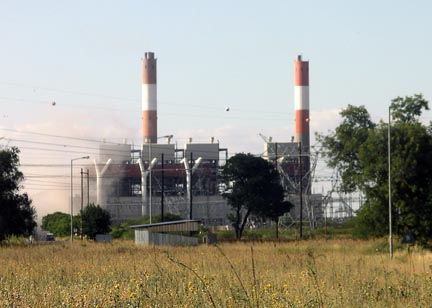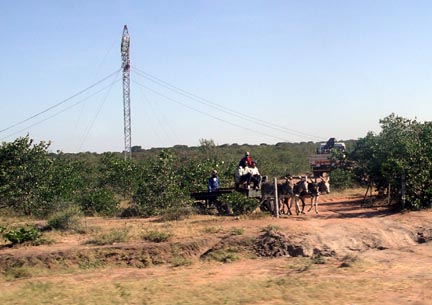I teach a class that involves, among other things, the use of power in mines. I was discussing how, in looking at the way in which power is used in those mines, prudent managers would designate the power going to different parts of the operation as vital, sheddable and avoidable. Some things, for example the large fans that keep air circulating through an underground mine, are vital to its operation. Some things, such as the operation of the pumps that drain the water from areas of the mine prone to flooding, can be rescheduled, in many cases, to off-peak periods, and some power use – such as running a conveyor when there is no production taking place, or keeping the lights on at the surface during daylight, can be eliminated. So I was talking about this, and three of the folk in the class commented that they had worked in mines in the United States, during the summer, and the mine had been asked to shed some load by the utility.
The most dramatic visible load shedding was, perhaps, the collapse of the power distribution network in Southern Africa, about this time last year. Essentially the power company ESKOM, had failed to keep up with demand, by properly maintaining the power stations and supplies, and planning ahead to match available production with the increasing demand that they were facing. The problem was not, however, limited to South Africa alone.
In the northern part of South Africa around Johannesburg, there are a number of coal mines and power plants. Surplus power could be sold into the neighboring countries to the North, so that they did not need to build their own plants, or start to develop their own deposits of coal. One such place was Botswana, just across the border, which had, at the time, one power plant, fed with coal from one mine, and with that mine having one mining machine to produce the needed coal.
Botswana is not yet a fully developed country. Only 35% of the population has access to electricity and until January 2008, they had assumed that their shortfall in domestically generated power would be made up by imports from South Africa. Their economy was booming, and their increased demand for power was being driven more by industrial growth than by rural electrification. And then in January, South Africa discovered that they no longer had enough power, and started load shedding. Given that they didn’t bother to inform the average person in Botswana before they did, a little disruption ensued. (http://allafrica.com/stories/200801280174.html).
I was down in Botswana a little later in the year (February) and this was the story that I posted to The Oil Drum at that time.
“I had mentioned earlier the problems that that country suddenly encountered when the source for 75% of its electric power – Eskom of South Africa – started to use it as a load-sheddable part of its distribution chain. It has since given Botswana the amounts that it can expect over the next four years. From a supply of 410 MW in 2007; it will get 350 MW in 2008; 250 MW in 2009; and 150 MW in 2010 through 2012. While the country has in-house generation, it decided some time ago that it was less costly to import power than to increase internal supply. Now it will take some time to create that internal power, from coal, of which the country has a more than adequate supply.
The expansion of the current plant, already in process, will not occur until 2010, and was planned to only add 120 MW, less by then, than the lost imports. And current growth in demand has been at 5.6% per annum. It does not help that:
It has also emerged that at the beginning of this year, the desperate BPC signed a no guarantees contract that allows Eskom to cut power supplies to Botswana within as little as ten minutes notice.
Flying into Gaborone, the capital, from Johannesburg, after reading the articles that had lead to the earlier pieces, I had expected to see that there would be some impact on behavior. But, crossing the veldt, there were lace points of light that reached out as long as I could see the ground. Once landed the streets were lit, and gas stations were running normally (at about $1 a liter). Going into meetings the following morning, it seemed to have been, at that scale, an irritant. We continued to meet, and then the lights went out, and the air conditioner shut off.
There were a couple of remarks, and we continued with the meeting (which wasn't about this), and about fifteen minutes later power came back on. There is no sense, from those I talked to, as to when each outage will occur, nor how long it will last. And what is an inconvenience in a discussion, becomes much worse, for a business. Longer outages have led to spoiled meat at restaurants and it is perhaps not surprising that virtually all the meals we had were served as buffets.
The problem was foreseen, and, as with the current world oil situation, there were voices that expressed concern. But while demand continued to grow, supply did not. Maintenance was not adequate, and there has been a continuing economic crisis in neighboring Zimbabwe which has led to their power stations shutting down, and power distribution collapsing.
The nation was sitting at the start of what looks to be a very promising future. As commodity prices rise it has the world’s second largest diamond mine as well as other, increasingly valuable minerals. The second largest industry is tourism, with beef production running third (it is the size of Texas, but has perhaps a sixth the size of that herd). Plans were well underway to increase electrification of villages, which had been only at around 12% toward universal access to power by 2016. Unfortunately, due in part to lack of training, use of solar power has not been as successful as had been hoped. And now, not only is there no new power to meet these future needs, there is not enough even for today.
So the Power Company has been scrambling to find answers wherever they can. Obviously there are some conservation measures, which include
replacement of incandescent lamps, which consume a lot of power. The director of transmission at BPC, Edward Rugoyi said the project is aimed at reducing power consumption to 30 MW by June this year.(The currency is the Pula, at about 6 to the dollar. They are coming out of summer, so air conditioning will not be an immediate burden, though it can get cool in the winter, that is still some months away.
Implementation will cost the corporation at least P20 million. Another initiative BPC will look at is load shifting, where the organisation will control domestic water heating by switching off water geysers during the peak period by using controls installed in their systems. Rugoyi said the exercise will cost P60 million and it is planned for May 2009.

Morupule Power Plant
For the longer term, the plan is to increase power from the Morupule Power Plant, to a new level of 300 MW, helped by the Chinese , tenders have been accepted to expand the Morupule plant to 300 MW by 2010, with incentives for fast-tracking. In the more immediate short term, Botswana has agreed to work with Zimbabwe in restoring and operating the currently dysfunctional power station at Bulawayo in Zimbabwe, with countries sharing 50:50 in the power produced from the coal that Botswana will supply. This will require new transmission lines.

New Power Transmission Lines near the Zimbabwean border in Botswana
In short – depending on how successful the arrangement with Zimbabwe turns out to be, Botwsana may have less than a year of discomfort, and, if the Chinese can perform to schedule, no more than a couple before becoming sufficiently independent of outside power supply that it can return to its planned progress forward. Much of that progress will likely build on the growth of the local mining industry, which is fairly energy dependent (as the South Africans are now well aware). Thus the plan is to continue to increase the size of the Moruplule plant with another 300 MW, once the first phase is completed.
Following the visit, and that story, I was pointed to a Web site – Energy Shortage that illustrates the places around the world where energy shortages are currently occurring. Among the countries that are listed for today (January 8,2009) are:
Argentina; India; Indonesia; Ireland; Nepal, and South Africa.
Note Ireland, it is a reminder, as power stations have started cancelling plans for expansion in the United States, of what might be coming to our light switch, if the correct planning is not put in place, now!
0 comments:
Post a Comment